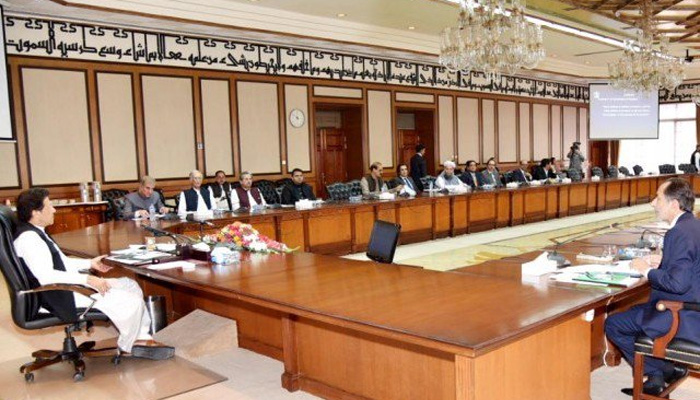The end of discretionary funds: rhetoric and reality
ISLAMABAD: In its meeting on Monday evening, the federal cabinet decided to abolish the discretionary funds of the prime minister, federal ministers and development funds for MNAs, a decision which has been widely projected as an unprecedented step by the Pakistan Tehreek-i-Insaf (PTI) government. The reality is quite the opposite.
Very few observers have cared to check whether these funds existed before. A sum of just Rs80 million a year used to be allocated to the prime minister, which he would largely spend on entertaining the applications of needy people for free medical treatment and the like. Even incumbent government officials agree this was not a substantial allocation.
A special fund of Rs1 million used to be allocated to each cabinet member, but had already been abolished by the previous government. The practice of releasing secret funds to different ministries had also been stopped by the Pakistan Muslim League-Nawaz (PML-N) administration; the intelligence agencies remained the only exception to this rule. The PML-N government had also announced the abolition of discretionary development funds to MNAs, although this practice continued under different official nomenclature.
So what is different? The hefty allocations made for development projects in the constituencies of ruling coalition MNAs is the key point. Abolishing this would really be a big test for the government. These funds are what the PTI government has decided to stop, terming them as "discretionary funds". Ideally, development is the domain of the local government apparatus, not that of federal lawmakers, since financial resources were largely devolved to the provinces under the 18th amendment to the constitution.
The abolition of these funds was promised in the PTI manifesto published in 2013. The party had announced an end to this practice in Khyber Pakhtunkhwa when it formed the government there five years ago. Did it keep the promise? The answer is negative.
Before pinning so much hope on such pledges, it is important to ascertain the fate of such measures announced in the past so as to spell out the challenges faced in translating rhetoric into reality. In the early days of the Nawaz Sharif government in 2013, there was a similar air of optimism. Austerity was the buzzword, as with the newly ensconced PTI government.
The first budget of the PML-N government unveiled a 45 per cent cut in the expenses of PM House, reducing it from Rs725 million a year to Rs396 million. However, they started increasing again from Sharif's second year in office onward. By the time the PML-N government presented its last budget in May, some Rs986 million was budgeted for PM House, significantly more than the slashed budget announced in 2013.
Likewise, non-development expenditures were trimmed by 30 per cent in line as part of the austerity drive at the time. This resulted in the slowing down of office work, as staff would complain of shortages of paper, ink and other supplies, and about restrictions on the use of telephones. Ultimately, the government had to backtrack on its decision to cut financial corners.
Similarly, a radical decision was taken by the erstwhile PML-N government to abolish development funds for MNAs. This was made controversial by the unconstrained abuse of the funds by former Pakistan People's Party (PPP) premier Raja Pervez Ashraf. He lavished funds totaling Rs47 billion on his native Gujar Khan, while a further Rs5 billion was granted to other influential PPP lawmakers and their allies.
When the matter was taken up by the Supreme Court, it directed action against Pervez and ruled that the allocation of discretionary funds to the prime minister and chief ministers for development projects was an unconstitutional practice. “The government is bound to establish procedure/criteria for governing allocation of such funds for this purpose,” the Supreme Court noted in its verdict on December 5, 2013.
When the PML-N formed the government, it initially refused to grant funds to MNAs for handpicked development schemes in their constituencies. Meanwhile, any announcement by the prime minister for, say, the construction of a road or the provision of piped natural gas, was routed through the Planning Division. The Nawaz Sharif government faced raucous opposition when it approved funds for the Rawalpindi-Islamabad metro bus project, with critics dubbing it a violation of the Supreme Court order in the Raja Pervez Ashraf case, although the plan was expedited via the Planning Division, not from any discretionary fund.
In an apparent attempt to counter-balance this criticism, Nawaz announced the establishment of 46 state-of-the-art hospitals across the country, a move which failed to make any headway due to the poor conception of the project. It gave rise to questions as to whether administrative charge and financing of the hospitals would be undertaken by provincial administrations or the federal government.
However, the government found itself under real pressure from MNAs to restore the funds after the destabilising crises created by the PTI-led dharna in 2014 and the Dawn leaks controversy in 2016. It was torn between obeying the court's order banning the discretionary allocation of development funds and appeasing lawmakers in the run-up to the 2018 general election.
It sought and found an innovative way of releasing the controversial grants. They were allocated under the heading of the United Nations' 17 Sustainable Development Goals, which require the government to invest in the provision of clean drinking water, energy and poverty alleviation - all through the Planning Division and mostly to treasury MNAs, with the major chunk allocated to politicians from Punjab.
The PTI provincial government in Khyber Pakhtunkhwa behaved no differently, violating its 2013 manifesto pledge and the Supreme Court's order. In 2014, PTI Chairman Imran Khan wrote a letter to the then chief minister, Pervez Khattak, directing him to stop the release for discretionary funds for himself, cabinet members and MPAs. What happened in reality is a matter of public record.
The following year (2015), Rs8.5 billion was released to MPAs. Whereas the PML-N government had made such allocations under the UN Sustainable Development Goals, the KP government did so under its Annual Development Programme, doling out funds in the form of special packages and district development initiatives. A significant chunk went to the constituencies of treasury lawmakers and ministers, according to according to Centre for Governance and Public Accountability (CGPA), which obtained the data courtesy of Right To Information (RTI) laws.
Another RTI request by the CGPA brought to the public's attention the fact that Khattak and his finance minister, Muzaffar Said, collectively spent Rs837 million in the financial year 2017-18 alone, sourcing it from the discretionary funds for local governments at their disposal.
Some Rs557 million was allocated to Khattak and Rs280 million to Said, according to the data obtained by the CGPA. The single highest allocation of Rs490 million was made for projects in Khattak’s home district of Nowshera, followed by Rs200 million to Said’s home district of Lower Dir.
-
 Alexander Skarsgard Breaks Silence On Rumors He Is Bisexual
Alexander Skarsgard Breaks Silence On Rumors He Is Bisexual -
 King Charles Faces Rift With Prince William Over Prince Harry’s Invictus Games
King Charles Faces Rift With Prince William Over Prince Harry’s Invictus Games -
 Elon Musk’s Critique On ChatGPT Safety Draws Sharp Response From Sam Altman
Elon Musk’s Critique On ChatGPT Safety Draws Sharp Response From Sam Altman -
 Katherine Ryan Takes Aim At Brooklyn Beckham In Fierce Defense Of His Parents
Katherine Ryan Takes Aim At Brooklyn Beckham In Fierce Defense Of His Parents -
 How Timothy Busfield, Melissa Gilbert Really Feel After Release From Jail
How Timothy Busfield, Melissa Gilbert Really Feel After Release From Jail -
 OpenAI, Bill Gates Launch ‘Horizon 1000’ To Transform AI Healthcare In Africa
OpenAI, Bill Gates Launch ‘Horizon 1000’ To Transform AI Healthcare In Africa -
 Prince Harry Receives Praises For Exposing Dark Side Of British Tabloids
Prince Harry Receives Praises For Exposing Dark Side Of British Tabloids -
 Andrew Forces Beatrice, Eugenie To Lose $60 Million Safety Net Saved For Retirement
Andrew Forces Beatrice, Eugenie To Lose $60 Million Safety Net Saved For Retirement -
 Nvidia CEO Jensen Huang To Visit China To Push Re-entry Into AI Chip Market
Nvidia CEO Jensen Huang To Visit China To Push Re-entry Into AI Chip Market -
 U.S. On Verge Of Losing Measles-free Title Due To Outbreak
U.S. On Verge Of Losing Measles-free Title Due To Outbreak -
 Harry Styles Excites Fans As He Announces Release Date Of New Song
Harry Styles Excites Fans As He Announces Release Date Of New Song -
 Japan’s Ex-PM Shinzo Abe’s Killer Is Set To Be Sentenced: How Much Punishment Could He Face?
Japan’s Ex-PM Shinzo Abe’s Killer Is Set To Be Sentenced: How Much Punishment Could He Face? -
 Prince Harry, Meghan Markle’s Return To UK Could Create Royal Family Dilemma
Prince Harry, Meghan Markle’s Return To UK Could Create Royal Family Dilemma -
 Prince Harry Turns Troubled With No Sense Of Home: ‘Isolation Is Getting To Him Mentally’
Prince Harry Turns Troubled With No Sense Of Home: ‘Isolation Is Getting To Him Mentally’ -
 Vitamin D Link To Respiratory Diseases Will Shock You
Vitamin D Link To Respiratory Diseases Will Shock You -
 A$AP Rocky Gives His Take On Children's Budding Personalities
A$AP Rocky Gives His Take On Children's Budding Personalities




